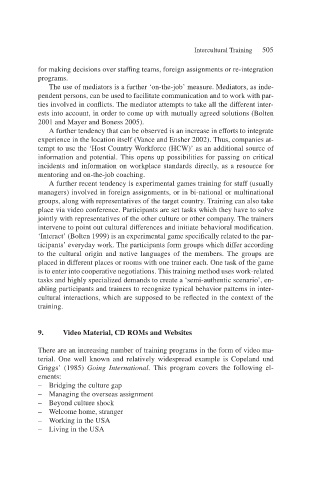Page 527 - Handbooks of Applied Linguistics Communication Competence Language and Communication Problems Practical Solutions
P. 527
Intercultural Training 505
for making decisions over staffing teams, foreign assignments or re-integration
programs.
The use of mediators is a further ‘on-the-job’ measure. Mediators, as inde-
pendent persons, can be used to facilitate communication and to work with par-
ties involved in conflicts. The mediator attempts to take all the different inter-
ests into account, in order to come up with mutually agreed solutions (Bolten
2001 and Mayer and Boness 2005).
A further tendency that can be observed is an increase in efforts to integrate
experience in the location itself (Vance and Ensher 2002). Thus, companies at-
tempt to use the ‘Host Country Workforce (HCW)’ as an additional source of
information and potential. This opens up possibilities for passing on critical
incidents and information on workplace standards directly, as a resource for
mentoring and on-the-job coaching.
A further recent tendency is experimental games training for staff (usually
managers) involved in foreign assignments, or in bi-national or multinational
groups, along with representatives of the target country. Training can also take
place via video conference. Participants are set tasks which they have to solve
jointly with representatives of the other culture or other company. The trainers
intervene to point out cultural differences and initiate behavioral modification.
‘Interact’ (Bolten 1999) is an experimental game specifically related to the par-
ticipants’ everyday work. The participants form groups which differ according
to the cultural origin and native languages of the members. The groups are
placed in different places or rooms with one trainer each. One task of the game
is to enter into cooperative negotiations. This training method uses work-related
tasks and highly specialized demands to create a ‘semi-authentic scenario’, en-
abling participants and trainers to recognize typical behavior patterns in inter-
cultural interactions, which are supposed to be reflected in the context of the
training.
9. Video Material, CD ROMs and Websites
There are an increasing number of training programs in the form of video ma-
terial. One well known and relatively widespread example is Copeland und
Griggs’ (1985) Going International. This program covers the following el-
ements:
– Bridging the culture gap
– Managing the overseas assignment
– Beyond culture shock
– Welcome home, stranger
– Working in the USA
– Living in the USA

